| |
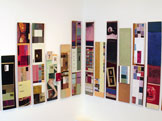
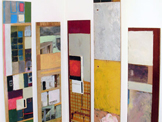
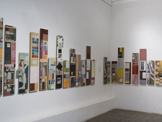
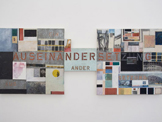


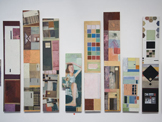
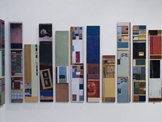
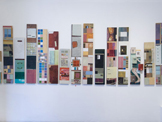

|
2009
Aug. 18th to Sep. 19th - Lascas [scraps] Painting as {a foreign?} language | Geraldo Souza Dias
Solo Exhibition
LASCAS
[Scraps] Painting as {a foreign?} language The mediation of Painting In the western tradition, the shape of the canvas is identified with a certain gender of Painting: Portraits are done in vertical canvases, while landscapes are painted in horizontal ones. The Installation “LASCAS – [Scraps] “ presented with other works in “LASCAS [Scraps] – Painting as a (foreign) language” by Geraldo Souza Dias subverts such a convention by showing a simultaneity of perspectives.
It comprehends 50 vertical paintings done on planks of wood, placed side by side, displaying a type of cityscape of horizontal apprehension, which take over three walls of the exhibiting space. With that procedure, the artist dislocates the bird’s eye view, which normally we have of the ground to a frontal look, reserved to the walls (and to the thereon hung paintings) and at the same time he divides that cityscape, supposedly continuous, into small pieces.
Here there is no longer any privileged view point for the total apprehension of the work. Each wood board is a fragment that constitutes at its own turn and according to the demand of the viewer a specific look. But taken altogether, they mimic the skyline of large cities, like São Paulo, out of which the taller skyscrapers stand out. The work invites us to an intense coming-and-going, a restless dislocation. Its encompassing demands movement from the viewer. Here, no doubt, we detect something of the very same kind of experience we have with the city: a kind of condemnation to a partial vision, upon which the totality imposes itself only in detriment of the understanding of each of its parts. Because each scrap or each fragment has a kind of autonomy, it shows itself as a complete entireness.
The 50 pieces are elaborated after the collage of several materials (magazines, newspapers, architectural plans, printed ads and comic books) which appear partially covered by a painting which mixes different paints, colors, techniques. As in a cubist collage, the representational space is interrupted by elements from the reality. Each painting shows a different universe, articulated around an image (painted or pasted on the wood), a phrase or a structure which organizes its inner visibility. We are faced with works that demonstrate an abrupt straightforwardness, successive plans that deny the three-dimensional perspective and refuse to accept our look. Like city walls, each painting lets see through it, what was previously behind, but not quite very clearly.
In these works, the operation of Painting itself is revealing. Painting is what makes that all the presences have same weight: a sentence taken out of an advertisement, the work of a well-known artist, an illustration. Painting operates ambiguously: it hides details but let see through it its differentiated origin. To Painting is conferred a kind of power that pacifies dissonances yet without erasing them completely. Thais Rivitti
|